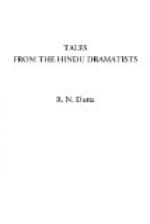Love, according to Hindu notions, is the subject of most of their dramas. The hero, who is generally a king, and already the husband of a wife or wives, is suddenly smitten with the charms of a lovely woman, sometimes a nymph, or, as in the case of Sakuntala, the daughter of a nymph by a mortal father. The heroine is required to be equally impressible, and the first tender glance from the hero’s eye reaches her heart. With true feminine delicacy, however, she locks the secret of her passion in her own breast, and by her coyness and reserve keeps her lover for a long period in the agonies of suspense. The hero, being reduced to a proper state of desperation, is harassed by other difficulties. Either the celestial nature of the nymph is in the way of their union, or he doubts the legality of the match, or he fears his own unworthiness, or he is hampered by the angry jealousy of a previous wife. In short, doubts, obstacles and delays make great havoc of both hero and heroine. They give way to melancholy, indulge in amorous rhapsodies, and become very emaciated. So far the story is decidedly dull, and its pathos, notwithstanding the occasional grandeur and beauty of imagery, often verges on the ridiculous. But, by way of relief, an element of life is generally introduced in the character of the Vidushaka, or Jester, who is the constant companion of the hero; and in the young maidens, who are confidential friends of the heroine, and soon become possessed of her secret. By a curious regulation, the jester is always a Brahman, and, therefore, of a caste superior to the king himself; yet his business is to excite mirth by being ridiculous in person, age, and attire. He is represented as grey-haired, hump-backed, lame and hideously ugly. In fact, he is a species of buffoon, who is allowed full liberty of speech, being himself a universal butt. His attempts at wit, which are rarely very successful, and his allusions to the pleasures of the table, of which he is a confessed votary, are absurdly contrasted with the sententious solemnity of the despairing hero, crossed in the prosecution of his love-suit. His clumsy interference with the intrigues of his friend, only serves to augment his difficulties, and occasions many an awkward dilemma. On the other hand, the shrewdness of the heroine’s confidantes never seem to fail them under the most trying circumstances; while their sly jokes and innuendos, their love of fun, their girlish sympathy with the progress of the love-affair, their warm affection for their friend, heighten the interest of the plot, and contribute not a little to vary its monotony.
Indeed, if a calamitous conclusion be necessary to constitute a tragedy, the Hindu dramas are never tragedies. They are mixed compositions, in which joy and sorrow, happiness and misery, are woven in a mingled web,—tragi-comic representations, in which good and evil, right and wrong, truth and falsehood, are allowed to mingle in confusion during the first acts of the drama. But, in the last act, harmony is always restored, order succeeds to disorder, tranquillity to agitation; and the mind of the spectator, no longer perplexed by the apparent ascendancy of evil, is soothed, and purified, and made to acquiesce in the moral lesson deducible from the plot.




